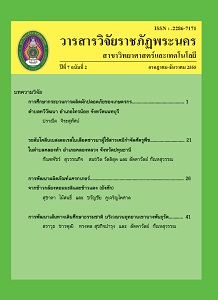กระบวนการผลิตผักปลอดภัยของเกษตรกร ตำบลทวีวัฒนา อำเภอไทรน้อย จังหวัดนนทบุรี
Keywords:
ผักปลอดภัย, การปนเปื้อน, safety vegetable, contaminationAbstract
การวิจัยครั้งนี้มีวัตถุประสงค์เพื่อศึกษาข้อมูลส่วนบุคคลของเกษตรกร กระบวนการผลิตและ การจัดจำหน่ายผักปลอดภัยในเขตตำบลทวีวัฒนา อำเภอไทรน้อย จังหวัดนนทบุรี โดยทำการวิเคราะห์ สารตกค้างและจุลินทรีย์ปนเปื้อนในผักปลอดภัย จำนวน 6 ชนิด ได้แก่ ผัก กวางตุ้ง ถั่วฝักยาว ผักตาลปัตรฤาษี ผักชุนฉ่าย ผักกุยช่ายขาว และผักบุ้งน้ำ โดยเก็บรวบรวมข้อมลูของเกษตรกรที่ปลูก ผักปลอดภัยจำนวน 50 คน โดยวิธีการสัมภาษณ์และสุ่มตัวอย่างผักจำนวน 1 กิโลกรัมต่อแปลงเพื่อวิเคราะห์สารตกค้างและจุลินทรีย์ ปนเปอื้นในผกั จากการศึกษา พบว่า เกษตรกรส่วนใหญ่เป็นเพศชายมีอายุ 41-50 ปี สถานภาพสมรส การศึกษาอยู่ ในระดับประถมศึกษา มีสมาชิกในครอบครัว 5-10 คน เช่าที่ดินเพื่อปลูกผัก อาชีพหลัก คือ ปลูกผัก อาชีพ รอง คือ รับจ้าง มีรายได้เฉลี่ยต่อเดือน เท่ากับ 5,000-10,000 บาทต่อครัวเรือน ประสบการณ์ปลูกผักอยู่ ระหว่าง 5-10 ปี เป็นสมาชิกสหกรณ์การเกษตร ได้รับข่าวสารทางการเกษตรจากเพื่อนบ้าน แหล่งความรู้ที่ ได้รับเกี่ยวกับการผลิตผักปลอดภัยจากเจ้าหน้าที่ส่งเสริมการเกษตร สภาพดินปลูกผักเป็นดินเหนียว ใช้แหล่ง นํ้าจากคลองชลประทาน โดยใช้เรือรดนํ้า เพิ่มผลผลิตโดยการใช้ปุ๋ยนํ้าชีวภาพ ไม่เคยวิเคราะห์สารพิษตกค้าง และจุลินทรีย์ปนเปื้อนในผักปลอดภัย มีการตกแต่งผักก่อนส่งไปจำหน่ายที่ตลาดขายส่ง มีความรู้ด้านการผลิต ผักปลอดภัยในระดับปานกลาง เกษตรกรทั้งหมดมีความรู้ด้านการทำการเกษตรที่ดีและเหมาะสม (GAP) ในระดับน้อย และมีความต้องการความรู้ด้านการผลิตและการจัดจำหน่ายผักปลอดภัยในระดับมาก ผลการตรวจวเิคราะห์สารตกค้างและจุลินทรีย ปนเปื้อนในผัก ปรากฏว่า ไม่พบสารตะกั่ว แคดเมียม และ เชื้อ Salmonella spp. แต่พบเชอื้ Escherichia coli ในผักกวางตุ้ง ผัก กุยช่ายขาว ผักชุนฉ่าย และถั่วฝักยาว ที่มี ค่าน้อยกว่ำ 10 cfu/g ในผักตาลปัตรฤาษีและผักบุ้งน้ำ ตรวจพบเชื้อ 2.8 x 10 2 cfu/g และ 5.0 cfu/g ตามลำดับ ซึ่งอยู่ในเกณฑ์มาตรฐานของ EU โดยกำหนดไว้
Procedure of Safety Vegetable Production in Tumbol Taweewattana, Ampher Sainoi, Nothaburi Province
The objective of this research was to study personal data of the grower productions process and commerce safety vegetables in Tumbol Taweewattana, Ampher Sainoi, Nonthaburi Province. These included analysis the residue and microorganism contaminations in six safety vegetables including pakchoi (Brassica campestris), yard long bean (Vigna sesquipedalis), yellow velvet leaf (Limnocharis flava), leaf mustard (Brassica chinensis), chinese chive (Allium tuberosum) and water convolvulas (Ipomoea aquatica). The data obtained from interviewing the fifty vegetable growers and sampling the vegetables (1 Kilogram/bedding) for determining the residue and microorganism contaminations. The results showed that the most growers were male, ages 41-50 years old, marriage, primary education level and 5-10 members in family. Most growers rented the land for growing the vegetable. Major occupation of the growers was growing the vegetable, additionally, minor occupation was an employee. The average income per month was 5,000-10,000 Bath per household. The experience of growers in vegetable cultivation was 5-10 years. Most growers were member of co-operative agriculture and received agricultural information from neighborhood. Additionally, the growers got the knowledge involving in safety vegetable productions from the agricultural extentionist. Soil condition in the farm was clay, in addition, irrigation obtained from the canal and watering by boat, and enhancement the yield by bio-fertilizer. However, the residue and microorganism contaminations in vegetables have never been analyzed. The yield of vegetable was trimmed before sending to the wholesale market. The vegetable growers had knowledge level about the safety vegetable productions at medium level, while the knowledge about Good Agricultural Practice (GAP) was low. The growers required knowledge of production and commercial safety vegetables at high level. Lead, cadmium and Salmonella spp. contaminations were not found. While Escherichia coli contaminated in pakchoi (Brassica campestris), chinese chive (Allium tuberosum), leaf mustard (Brassica chinensis) and yard long bean (Vigna sesquipedalis) were lower than 10 cfu/g. In addition, the contamination of Escherichia coli in yellow velvet leaf (Limnocharis flava) and water convolvulas (Ipomoea aquatica) was 2.8 x 102 cfu/g and 5.0 cfu/g, respectively. These results indicated that the six safety vegetables produced by growers in Tumbol Taweewattana complied with EU Standard.
Downloads
Issue
Section
License
โปรดกรอกเอกสารและลงนาม "หนังสือรับรองให้ตีพิมพ์บทความในวารสารวิจัยมหาวิทยาลัยราชภัฏพระนคร สาขาวิทยาศาสตร์และเทคโนโลยี" ก่อนการตีพิมพ์




